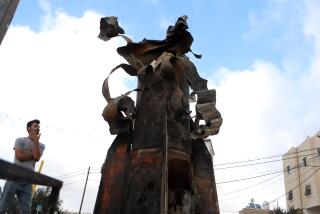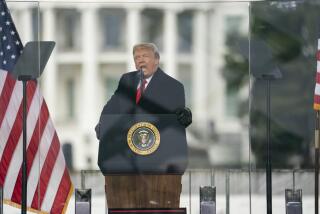The overthrow of democracy in Iran
All the Shah’s Men
An American Coup and the Roots of Middle East Terror
Stephen Kinzer
John Wiley & Sons: 258 pp., $24.95
*
Fifty years ago, the CIA overthrew Mohammad Mossadegh, the popular, democratically elected prime minister of Iran, and reinstalled the country’s exiled monarch, Mohammad Reza Shah. In “All the Shah’s Men,” Stephen Kinzer, a longtime New York Times correspondent, covers this event in an exciting narrative. He questions whether Americans are well served by interventions for regime change abroad, and he reminds us of the long history of Iranian resistance to great power interventions, as well as the unanticipated consequences of intervention.
Mossadegh’s overthrow in 1953 undermined Iran’s progress toward democracy and independence, shored up a dictatorial monarchy backed by the United States and ultimately strengthened the only opposition the shah could not suppress -- the Islamic opposition. Although Mossadegh’s government was more popular than today’s Iranian regime, it was depicted in the U.S. media as unpopular, and the coup against it was portrayed as a popular victory.
The coup was the first of a series of secret U.S. interventions to overthrow popular elected governments, including those in Guatemala (1954) and Chile (1973), and to replace them with regimes that were, like the shah’s, oppressive and unpopular. Kinzer’s detailed examination of this paradigmatic intervention (whose consequences continue to reverberate) is instructive.
On Aug. 19, 1953, Mossadegh was overthrown in a coup led by U.S. agents in a plan devised by the British Secret Service. Though a few Americans and many Iranians blamed the United States and Britain, the official and widely accepted American story was that this was a spontaneous popular uprising. In fact, as Kinzer convincingly relates, the coup was the product of careful planning and some on-the-scene improvisations by its chief U.S. agent, Kermit Roosevelt Jr., grandson of Theodore Roosevelt.
The coup transformed a constitutional monarchy with real political parties into an absolute monarchy in which elections and parliament were completely subject to the will of the shah. Because growing dissent had no licit political outlet, Ayatollah Khomeini and those clergy who followed him grew stronger and, in 1978, encouraged the series of popular demonstrations that led to the shah’s overthrow in February 1979.
The writing of “All the Shah’s Men” was made possible, as Kinzer says in his acknowledgments, by the research and writing of Mark Gasiorowski and other scholars. They have done the hard work of digging through official documents and interviewing ex-CIA and other persons to piece together this important story, some of which has already appeared in books and articles, with more to appear in the forthcoming “Mohammad Mosaddeq and the 1953 Coup in Iran” (Syracuse University Press), edited by Gasiorowski and Malcolm Byrne.
Kinzer shows the extreme reaction of the British when the Iranian parliament, in 1951, voted to nationalize the Anglo-Iranian Oil Co., most of whose shares were owned by the British government. Nationalization was a response to Britain’s refusal fundamentally to change its existing exploitative concession. The British, despite their Labor government’s nationalization of several British industries, refused to accept either a 50-50 profit sharing agreement or the compensated nationalization the Iranians offered. The British Secret Service planned Mossadegh’s overthrow, but, with Harry S. Truman as president, the United States refused to join the British.
Kinzer attributes this refusal to the cited views of Truman and Secretary of State Dean Acheson, but some scholars think the U.S. government and oil companies did not want Anglo-Iranian to continue its monopoly in Iran with its uniquely favorable terms. Unfortunately, the political motivations of leaders are more easily documented than the economic motives of politicians with ties to oil, international finance and armaments.
When Dwight D. Eisenhower became president in 1953, he brought with him the Dulles brothers -- John Foster as secretary of state and Allen as head of the CIA. Both had big business backgrounds and thought Iran’s nationalization threatened oil concessions everywhere. An alarming situation was presented to the American and British public: that Iran’s communist Tudeh Party was about to take over a strategic country bordering the Soviet Cold War foe, and that Mossadegh’s moves were a threat to Western oil access. (In fact, all oil-exporting countries, even communist ones, were eager to sell oil to the West, their most important market.) What was threatened, Kinzer shows, was not access to Iranian oil but the huge profits of oil companies. The communist threat argument was weak, as nationalists were far stronger and would be further strengthened by international recognition of oil nationalization.
Even before taking office, the Dulles brothers dealt with the British regarding Mossadegh’s overthrow and soon convinced an initially doubtful Eisenhower. Winston Churchill and his Conservatives had defeated the Labor government and had launched an aggressive series of anti-Mossadegh operations that caused Iran to break diplomatic relations and expel all British subjects. Hence the British handed over to the Americans their coup plans and ties to Iranian operatives. Money was liberally distributed to Iranian agents, who handed out some of it to mobs under their control.
Several dramatic points of the plot stand out in Kinzer’s account. One is the failure of the original coup plot, of which Mossadegh got prior warning, followed by the improvisation of Roosevelt. A striking feature of the new plan was its use of agents provocateurs, a point documented by Gasiorowski in his 1991 book “U.S. Foreign Policy and the Shah: Building a Client State in Iran.”
Key to Roosevelt’s plan was the payment of fake nationalist and Tudeh mobs that rampaged through Tehran with radical anti-royalist slogans, overthrowing statues of the Pahlavi shahs and other monarchic symbols. Mossadegh had to call in the police to put down the mobs with much force, and he called for people to stay home and not demonstrate. The absence of crowds supporting Mossadegh gave Roosevelt the opening to use a paid-off mob, led by thugs and athletic strongmen, on Aug. 19. Roosevelt had also made arrangements with Gen. Fazlollah Zahedi, a former Nazi collaborator, to become prime minister, and he informed the shah, who had fled to Rome with Queen Soraya, of the situation in the streets.
With the support of the mob and some military, the coup succeeded. The Tudeh, owing to divisions and to Mossadegh’s acts and orders against demonstrations, did not send cadres to the streets, nor did the nationalists. Mossadegh and much of his Cabinet were arrested, and Zahedi became prime minister. The United States began pouring in economic and military aid, backing the shah as guardian of the region.
A 1954 oil agreement retained nationalization in name only, with real power going to a consortium consisting of Anglo-Iranian, U.S. companies and a few international companies. Over the decades there was a reinstatement of nationalization, though, as long as it was under the shah, the U.S. did not worry and U.S. companies profited from oil distribution.
At the time, the coup seemed a great success for U.S. policy. Since 1979, its success seems doubtful. American hostility to nationalists such as Mossadegh, Sukarno in Indonesia and Gamal Abdel Nasser in Egypt encouraged major governmental changes, but neither the governments that followed nor the Islamist movements that grew up once nationalism and communism failed resulted in policies favorable to their peoples or, ultimately, to the U.S. The day when Western governments controlled governments in non-Western areas has passed, as their people no longer accept such foreign intervention.
As Kinzer’s book suggests, had the 1953 coup not occurred Iran might well have by now developed its parliamentary monarchy to become a full-fledged functioning democracy. The coup gave heart to U.S. leaders who wanted to overthrow governments considered threats, yet the ultimate anti-U.S. “blowback” against these operations in Iran and elsewhere has not inhibited future plans to change other governments.
More to Read
Sign up for Essential California
The most important California stories and recommendations in your inbox every morning.
You may occasionally receive promotional content from the Los Angeles Times.










